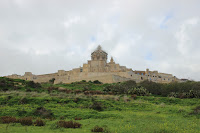We
left Corfu and cruised overnight into one of those rare half-day ports of call,
arriving in Valetta, Malta at 1730. During the day we did some laundry, read,
worked on the blog, and attended a talk.
 |
| Valetta waterfront |
Throughout the day the wind and seas
started to increase noticeably, but when the captain came on with his daily
update, he said, ‘but that’s the way it is supposed to be!’ Upon arrival in
Valetta, the ship was almost immediately cleared for passengers to disembark
and many did. However, we had made reservations in the Italian specialty
restaurant for 1900 and didn’t feel we had time to do getting off justice.
 |
| Valetta harbor |
Unlike
our previous specialty restaurant experience, this one was just perfect with outstanding
choices and food, and really attentive and congenial service. It made us feel like
we were somewhere in Italy and pretty soon someone would start singing opera.
 |
| Sunrise over Valetta |
After
dinner we attended a Beatles tribute at the pool deck followed by ‘Dancing
Under the Stars,’ but we were too lethargic from our heavy meal to even think
about trying to dance on a swaying deck.
The next morning we
were really excited about touring Valetta and Malta as we really impressed by
the uniqueness in the stone buildings and architecture.
 |
| Some church in Valetta |
The Republic of Malta
is an inhabited three-island archipelago with 18 smaller uninhabited islands 50
miles south of Sicily. With a population just under 450,000 and a land area of
only 122 sq. miles, Malta is the world’s smallest and most densely populated
country.
 |
| Maltese luzzu fishing boats |
Its location in the central Mediterranean has historically
given it great strategic importance as a naval base, and a succession of
powers, including the Phoenicians, Carthaginians, Romans, Moors, Normans, Sicilians,
Spanish, Knights of St. John, French and British, have ruled the islands. British
rule has probably been most influential as today the official languages of
Malta are Maltese (with North African origins) and English. The country is a
member of the European Union.
 |
| St. Anne's Parish Church |
 |
| Maltese delicacies |
We had signed up for the included scenic driving tour of
Valetta and Malta, and our group left at 0900 for a three-hour tour. th century
onward with most being Baroque in character. We wound our way through the
Valetta’s outskirts and headed for our first stop; the Maraskala fishing village.
Here we saw the colorful, traditional Maltese ‘luzzu’ fishing boats in the harbor.
We walked down to a nearby square that was anchored by St. Anne’s Parish
Church, but which didn’t open until later in the day. After waiting an additional
20 minutes for one straggler that hadn’t returned to the bus, we finally left
only to be turned around by the tour headquarters to go back and find the guy. He
was located on another bus and really caught hell when he finally came aboard!
 |
| The Blue Grotto |
Valetta has
a population of around 6500 with a surrounding metropolitan area of 395,000. Since
Valetta was built during the rule of the Order of St. John or the Knights of
the Hospitaller, all of the buildings date from the 16
 |
| Blue Grotto landscape |
Leaving Maraskala (Marsaxlokk in Maltese), we headed for the
town of Zurrieq, one of Malta’s oldest towns and home to the Blue Grotto, a
series of sea caverns carved by the sea’s waves.
It was drizzling rain, but the
views of the caverns were amazing in spite of the treacherous walk to view
them.
 |
| St. John's Island with rainbow |
We also saw the flat-top, rocky island of Filfla which is a rest stop for
birds migrating between Africa and Europe. Re-boarding our bus, we passed
through some rural, agricultural areas of Malta, finally arriving at the
medieval, fortified city of Mdina.
 |
| City of Mdina |
Today Mdina has a population of only around
300, but was once the capital of Malta. We stopped and took pictures of this
fortress city. Leaving Mdina, we headed toward the coast again passing the
resort area of Xemxija Bay and St. Paul’s Bay and Island. The apostle St. Paul
was on a ship heading for Rome for his beheading, when the ship was shipwrecked
on St. Paul’s Island in 60AD.
 |
| Valetta Christmas decorations |
|
|
|
He spent a brief period on this island before
proceeding to Rome to be martyred four years later. We left Xemxija Bay and
headed back to the cruise terminal to conclude our tour.
 |
| Departing shot |
|
|
|
 |
| Departing shot |
 |
| Departing shot |
 |
| Departing shot | | | | |
|
|
|
|

















No comments:
Post a Comment